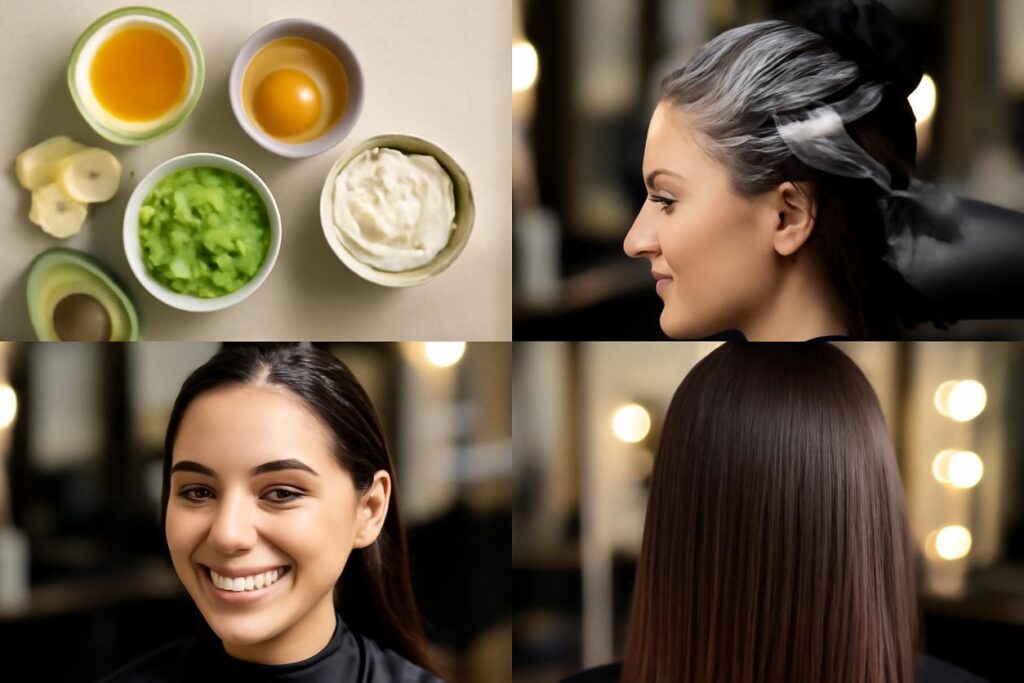Quick overview of frizz and who it affects
We’ve all been there. You spend time perfecting your hairstyle, only to step outside and have your smooth strands transform into a rebellious cloud of frizz. This frustrating phenomenon, often called a “frizz halo,” is a universal hair concern. While it can affect anyone, it is particularly common for individuals with wavy, curly, coily, or damaged hair. The quest for effective frizz control isn’t about forcing your hair to be something it’s not; it’s about understanding its unique needs to help it look its best, rain or shine.
Frizz is essentially a hair strand or group of strands standing up or curling away from the main body of your hair. It’s a sign that your hair cuticle, the outermost layer of the hair shaft, is raised and open instead of lying flat and smooth. This allows moisture from the air to penetrate the hair shaft, causing it to swell and create that dreaded frizzy texture. Mastering frizz control is about learning how to keep that cuticle sealed and your hair properly moisturized from within.
The science of frizz: humidity, hair structure and damage
To truly achieve lasting frizz control, it helps to understand what’s happening on a microscopic level. Think of each hair strand as being covered in tiny, overlapping scales, much like the shingles on a roof. This is the hair cuticle. When hair is healthy and well-moisturized, these cuticles lie flat, creating a smooth, light-reflecting surface. This smooth surface prevents excess moisture from getting in and keeps the hair’s internal moisture locked inside.
However, when hair is dry, damaged from heat or chemical treatments, or naturally porous, these “shingles” lift up. This creates a rough, dull surface and, more importantly, an open door for humidity. Humidity is simply water vapor in the air. When your raised cuticles are exposed to humidity, these water molecules rush into the hair shaft, causing it to swell unevenly. This swelling and distortion are what we see as frizz. Therefore, the core principle of frizz control is to maintain a healthy, sealed cuticle to create a barrier against atmospheric moisture.
Porosity and texture explained
Not all hair reacts to humidity the same way, and two key factors determine your personal battle with frizz: porosity and texture.
- Porosity: This refers to your hair’s ability to absorb and retain moisture. It’s determined by the state of your hair cuticle.
- Low Porosity: Cuticles are tightly packed and lie flat. This hair type resists moisture absorption (it takes a long time to get wet) but is good at holding onto it once it’s in. It’s less prone to humidity-induced frizz but can be weighed down easily by heavy products.
- Medium Porosity: The cuticles are slightly looser. This is often considered the “ideal” porosity, as it absorbs and retains moisture well. It requires a balanced approach to frizz control.
- High Porosity: The cuticles are raised or have gaps, often due to genetics or damage. This hair absorbs moisture instantly but also loses it just as quickly, making it highly susceptible to frizz.
- Texture: This refers to the thickness of individual hair strands.
- Fine: Strands are thin and delicate. Prone to being weighed down, so lightweight frizz control products are essential.
- Medium: The most common hair texture, it offers more body than fine hair.
- Coarse: Strands are thick and strong. This texture can be more prone to dryness and requires richer, more emollient products to keep frizz at bay.
Daily routines for low, medium and high porosity hair
A consistent routine is the foundation of successful frizz control. Customizing your approach based on your hair’s porosity will yield the most significant and lasting results.
Simple morning routine for smoother strands
Your morning routine should focus on refreshing your style while maintaining a smooth cuticle.
- Low Porosity Hair: Your hair likely repels water, so a light mist of water or a steam shower can help refresh curls without soaking the hair. Avoid heavy oils or creams in the morning as they will just sit on top of the hair.
- Medium Porosity Hair: A light leave-in conditioner spray can redefine your hair pattern and provide a touch of moisture. You can scrunch in a small amount of gel or mousse for hold and frizz control throughout the day.
- High Porosity Hair: Your hair loses moisture quickly overnight. It’s crucial to re-hydrate with a water-based leave-in conditioner and then immediately seal that moisture in with a lightweight oil or cream to block humidity.
Evening care and wash day protocol
What you do at night and on wash day is just as important for all-day frizz control.
For evening care, protecting your hair from friction is key. Sleeping on a silk or satin pillowcase reduces friction that can rough up the cuticle. Alternatively, loosely tying your hair in a “pineapple” (a high, loose ponytail on top of your head) or protecting it with a satin scarf or bonnet achieves the same goal.
Your wash day protocol should focus on gentle cleansing and maximum hydration:
- Use a Sulfate-Free Shampoo: Sulfates can strip the hair of its natural oils, leading to dryness and raised cuticles. Focus on cleansing the scalp, not the lengths of your hair.
- Deep Condition Regularly: This is non-negotiable for frizz control. High porosity hair may benefit from a weekly deep conditioning treatment with some protein, while low porosity hair might prefer a protein-free hydrating mask every two weeks.
- Apply Products to Wet Hair: Apply your leave-in conditioner, cream, and gel to soaking wet hair. This helps the products distribute evenly and traps water in the hair shaft, which is the ultimate goal of frizz control.
- Avoid Rough Towel Drying: Vigorously rubbing your hair with a traditional terrycloth towel is a primary cause of frizz. Instead, gently squeeze out excess water with a microfiber towel or an old cotton t-shirt.
Ingredient guide: what helps and what to avoid
Navigating product labels can be confusing. Understanding a few key ingredient categories will empower you to choose products that genuinely help with frizz control rather than making it worse.
Oils, humectants and proteins explained
| Ingredient Type | Function for Frizz Control | Examples | Best For |
|---|---|---|---|
| Oils (Emollients and Occlusives) | They smooth the cuticle and create a protective barrier to lock in moisture and block out humidity. | Argan oil, jojoba oil, shea butter, avocado oil, silicones (like dimethicone). | High porosity hair and coarse textures. Low porosity should use lighter oils like grapeseed sparingly. |
| Humectants | They attract water molecules from the air into the hair shaft to keep it hydrated. | Glycerin, hyaluronic acid, panthenol, honey, agave nectar. | Medium and low porosity hair in moderate humidity. In very high humidity, they can pull in too much moisture and cause frizz. |
| Proteins | They temporarily fill in gaps in the damaged hair cuticle, strengthening the strand and making it smoother. | Hydrolyzed keratin, silk protein, wheat protein, collagen. | High porosity and damaged hair. Use in moderation to avoid “protein overload,” which can make hair stiff and brittle. |
Ingredients to approach with caution include drying alcohols (like alcohol denat, isopropyl alcohol) often found in hairsprays and some styling products, which can dehydrate hair. Also, be mindful of overusing sulfates in shampoos, as mentioned earlier.
Styling tools and heat best practices
Heat styling can be a fantastic tool for creating a sleek, frizz-free finish, but it can also be a primary source of cuticle damage if not used correctly. The key is to minimize damage while maximizing your frizz control efforts.
Blow drying and flat iron techniques to minimize frizz
Executing the right technique is crucial for a smooth outcome. For any heat styling in 2025 and beyond, these rules are fundamental.
- Always Use a Heat Protectant: This is your first line of defense. A good heat protectant creates a barrier between your hair and the hot tool, reducing moisture loss and damage.
- Use the Nozzle on Your Blow Dryer: The concentrator nozzle directs the airflow down the hair shaft, encouraging the cuticles to lie flat. Without it, you are just blowing air in every direction, which invites frizz.
- Dry in Sections: Working with small, manageable sections ensures that each part of your hair is dried or straightened evenly and efficiently, reducing the need to go over the same section multiple times.
- Maintain Low to Medium Heat: The highest heat setting is rarely necessary and is a fast track to damage. Find the lowest effective temperature for your hair type.
- Point the Dryer Downwards: Always direct the airflow from the root down to the ends. This works with the natural direction of your cuticles, smoothing them down for a shinier, less frizzy result.
Emergency fixes for high humidity days
Sometimes, despite your best efforts, frizz happens. Here are a few quick fixes for instant frizz control when you’re on the go.
- The Hand Lotion Trick: In a pinch, rub a very small, pea-sized amount of a silicone-free hand lotion between your palms and lightly smooth it over the frizzy areas.
- Use a Smoothing Serum or Oil: Keep a travel-sized anti-frizz serum or a lightweight hair oil with you. Apply a tiny drop to your palms, rub them together, and gently glide them over the surface of your hair.
- Tame Flyaways with Hairspray: Spray a flexible-hold hairspray onto a clean toothbrush or spoolie and gently brush down any flyaways around your hairline or part.
- Strategic Styling: When all else fails, a sleek bun, a chic braid, or a stylish topknot can hide frizz while still looking polished and intentional.
Long term care and nutrition for resilient hair
Truly effective, long-term frizz control goes beyond surface-level treatments. The health of your hair is a reflection of your overall wellness. A balanced diet rich in vitamins and minerals is foundational. Key nutrients for hair health include:
- Biotin and B-Vitamins: Found in eggs, nuts, and whole grains.
- Iron: Crucial for preventing hair loss; found in spinach, lentils, and red meat.
- Protein: Your hair is primarily made of protein, so ensure adequate intake from sources like chicken, fish, beans, and tofu.
- Omega-3 Fatty Acids: Found in salmon and walnuts, they help keep your scalp and hair hydrated.
Additionally, getting regular trims every 8-12 weeks is vital. This removes split ends before they can travel up the hair shaft and cause more damage and frizz. Staying hydrated by drinking plenty of water also contributes to healthier, more resilient hair from the inside out.
Sample routines by hair type and length
Here are some sample routines to tie all the concepts together for a solid frizz control plan.
| Hair Type | Wash Day Protocol | Daily Styling |
|---|---|---|
| Fine, Wavy, Low Porosity | Cleanse with a sulfate-free shampoo. Use a lightweight, protein-free conditioner, avoiding the roots. Apply mousse to soaking wet hair and scrunch. Plop with a t-shirt for 20 mins, then air dry or diffuse on low speed/low heat. | Refresh in the morning with a light water mist. Avoid heavy products. Sleep with hair in a loose bun on a satin pillowcase. |
| Medium, Curly, Medium Porosity | Co-wash or use a moisturizing shampoo. Deep condition with a balanced moisture/protein mask. Apply leave-in conditioner, a curl cream, and a medium-hold gel using the “praying hands” method to wet hair. Diffuse or air dry. | Protect hair at night in a satin bonnet. Refresh in the morning by spraying with water and a bit of leave-in, then lightly scrunching to revive curls. |
| Coarse, Coily, High Porosity | Pre-poo with oil before washing. Cleanse with a very moisturizing shampoo. Deep condition with a rich, reparative mask. Apply products in the L.O.C (Leave-in, Oil, Cream) method to soaking wet hair in small sections. | Sleep in a satin scarf. Re-moisturize daily as needed with a spray and seal with a butter or heavy cream to combat moisture loss and ensure robust frizz control. |
Frequently asked questions
Why is my hair frizzy even if it’s not humid?
Frizz is primarily caused by a lack of moisture within the hair strand. Even in dry weather, if your hair is dehydrated or damaged, the cuticle will be raised, creating a rough, frizzy texture. The key to frizz control is consistent hydration, regardless of the weather.
Do silicones help or hurt frizz?
Silicones get a bad rap, but they can be very effective for frizz control. They work by creating a waterproof coating around the hair shaft, which smooths the cuticle and blocks humidity. The key is to use water-soluble silicones (like those ending in -cone with a “PEG-” prefix) and to clarify your hair regularly to prevent buildup.
Can I ever completely get rid of frizz?
Frizz is a natural characteristic of many hair textures, not a flaw to be eliminated entirely. The goal of a good frizz control routine is not to achieve an unrealistic, permanent state of smoothness but to manage frizz so that your hair is healthy, defined, and looks its best in its natural state.
Resources and further reading
Understanding the science behind your hair is a continuous journey. For in-depth articles on hair health, ingredient breakdowns, and tailored advice for different hair types, exploring resources from hair care experts can be incredibly beneficial. A great place to start for professional insights and quality information is Rich Hair UK. For persistent issues, consulting with a certified trichologist or dermatologist can provide personalized guidance.






